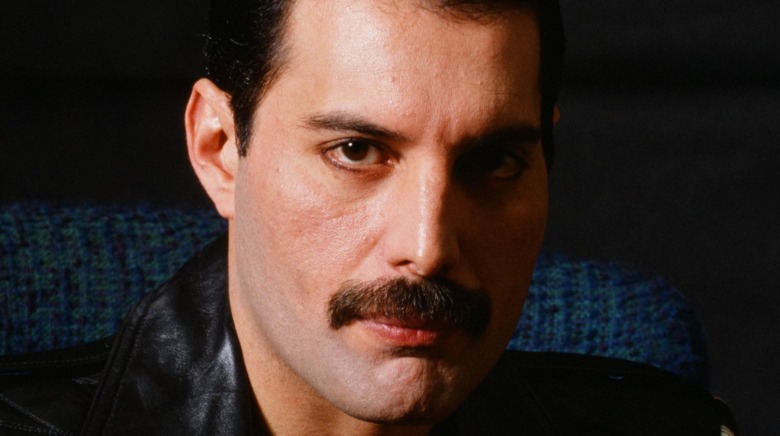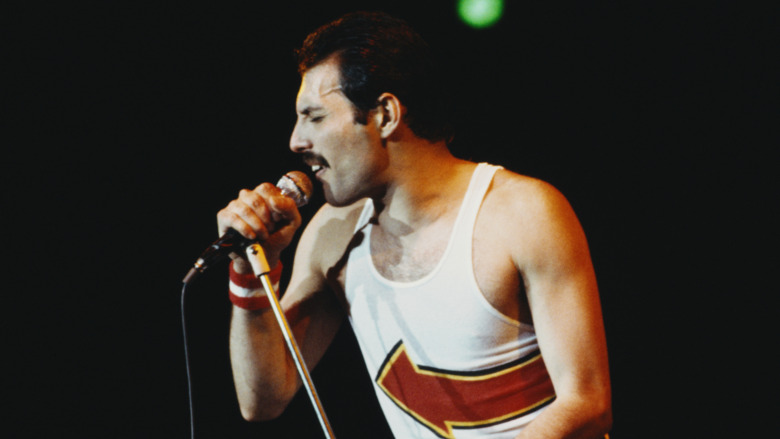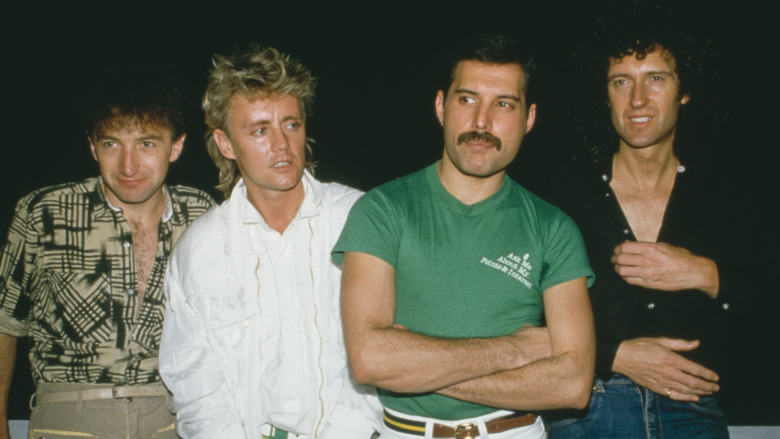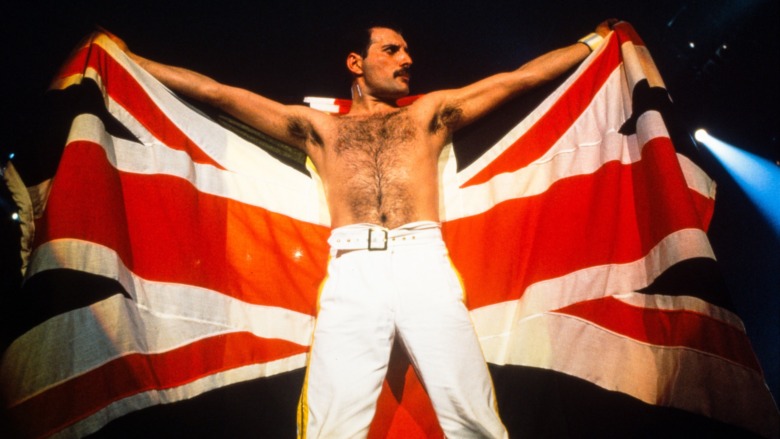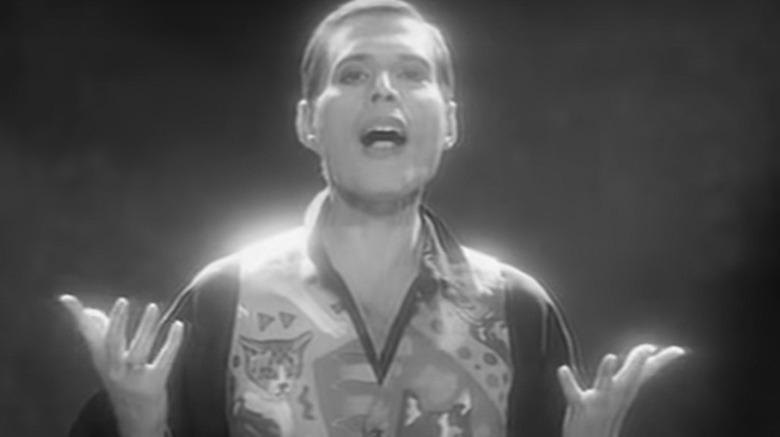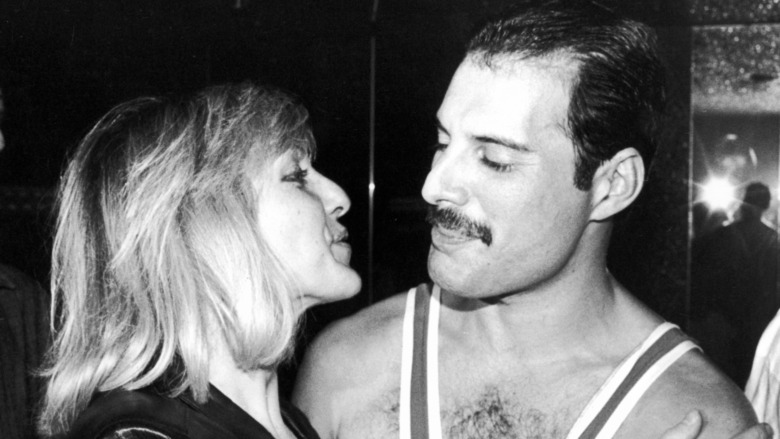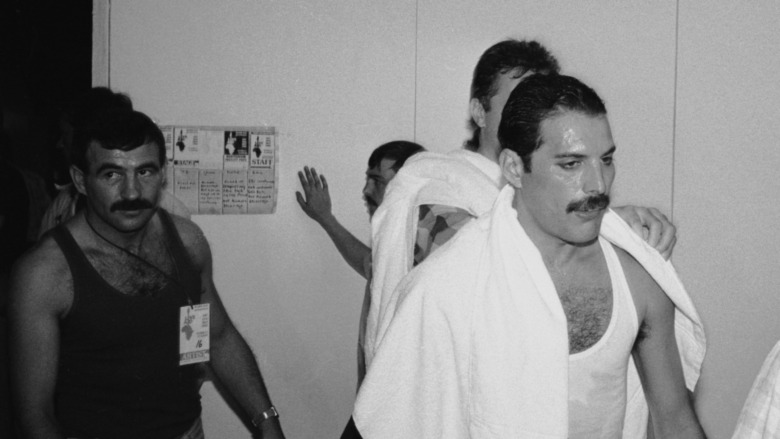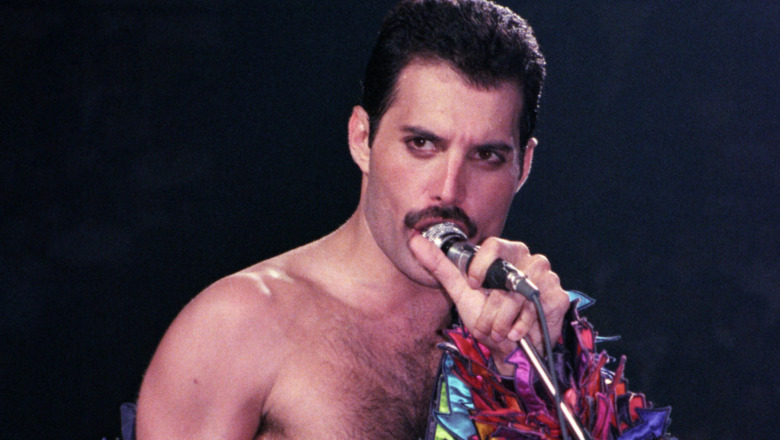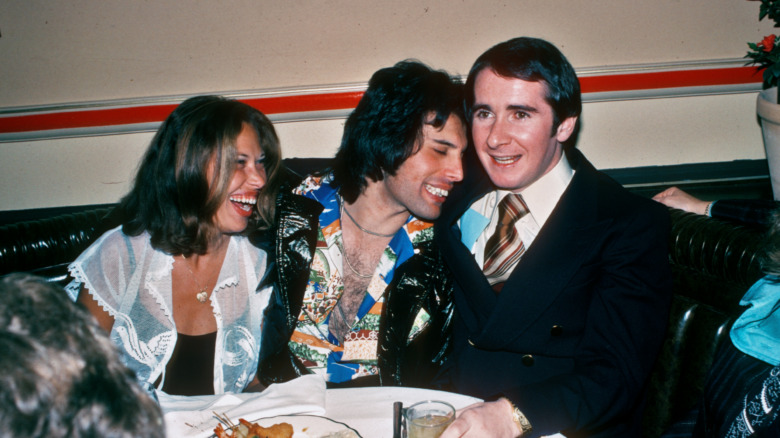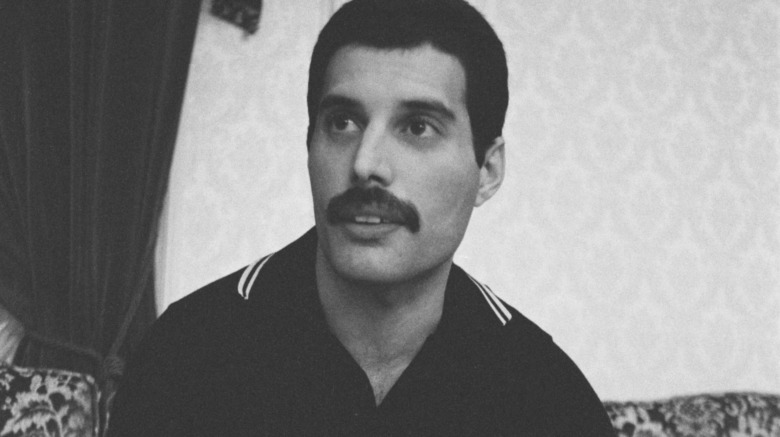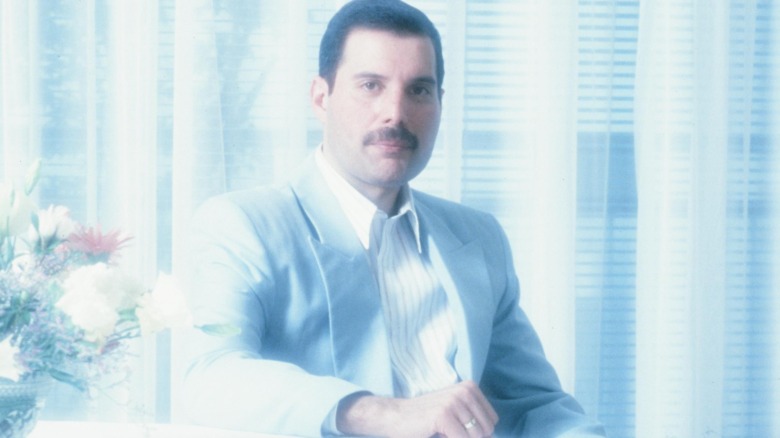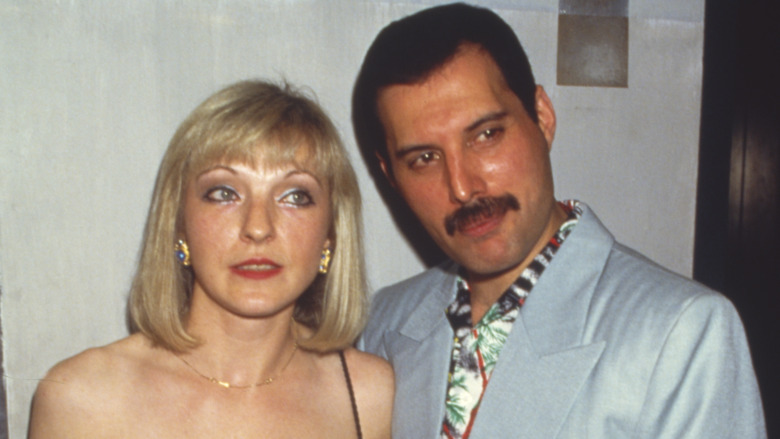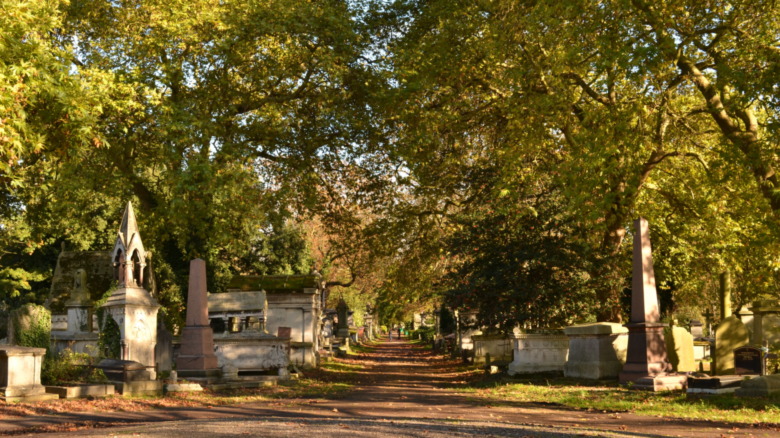The Final Year Of Freddie Mercury's Life, Explained
Few artists have eclipsed Freddie Mercury's white-hot stardom. Whether you've stomped to "We Will Rock You" in a packed stadium or sang your heart out to "Bohemian Rhapsody" while stuck in rush hour traffic, the odds are high that you've belted the Queen front man's words at some point in your life. Mercury's smooth vocals and magnetic stage presence catapulted Queen to the top of the charts in the 70s and 80s, so when the singer died from AIDS in 1991, the world was in shock.
Rather than be known for his disease, Mercury wanted to "make as much music as humanly possible" with his remaining time, according to guitarist Brian May in an interview with The Telegraph. Although public rumors about the state of his health increased when he stepped out of public life in 1989, Mercury and his bandmates vehemently denied rumors that the star had AIDS until the day before he died, when he released a statement regarding his illness (via People). Mercury was far from the first celebrity to tragically die of AIDS — however, his public acknowledgment of the disease was crucial at a time when governments had still done very little to address the epidemic.
Today, AIDS patients can live long and healthy lives — according to the San Francisco AIDS Foundation, people who start antiretroviral therapy (ART) early have a nearly 80-year life expectancy — but Mercury was diagnosed at a time when very few treatments existed, knowing his condition was terminal for years before his death.
Rumors about his health started early
According to Matt Richards and Mark Langthorne's book detailing Mercury's death, "Somebody to Love," rumors about Freddie Mercury's health began to circulate when The Sun printed a story that the singer had taken an HIV/AIDS test with the headline "Queen Star Freddie in AIDS Shock." Richards and Langthorne write that Mercury surprised his partner Jim Sutton by being uncharacteristically upset about the rumor. When a reporter from The Sun asked him for a statement, Mercury became defensive, saying, "Do I look as though I am dying? I'm perfectly fit and healthy, thank you." Whether or not Mercury had actually taken a test at this time is up for debate — rumors about stars contracting the disease were common tabloid fodder, although Richards and Langthorne claim that Mercury allegedly took at least ten HIV tests in 1986.
Mercury's snappy response was unsurprising given the public discourse surrounding AIDS in the 1980s, which was rife with victim-blaming and homophobia. Take the first ominous lines of this infamous 1987 Australian public service announcement: "At first, only gays and IV drug users were being killed by AIDS. But now, we know every one of us could be devastated by it." The ad pits the boogeyman of "gays and IV drug users" against "every one of us," and seems to place the blame on those most affected rather than the disease itself. Throughout the course of his illness, Mercury hid the details of his diagnosis from all but his closest inner circle.
Freddie Mercury hid his diagnosis from his bandmates
In "Somebody to Love," Matt Richards and Mark Langthorne write that Freddie Mercury was officially diagnosed with HIV/AIDS in 1987 when a biopsy on a lesion on his shoulder came up positive for Kaposi's sarcoma, a complication of AIDS. According to Rolling Stone, Mercury's ex-girlfriend Mary Austin was the first to receive the news: "After trying to reach Mercury on several occasions with no reply, his doctor's office then contacted Austin and shared the urgency of the matter with her: Mercury was now diagnosed as HIV-positive."
In 1989, Mercury felt that it was finally time to reveal his diagnosis to his bandmates. Drummer Roger Taylor told Rolling Stone that Mercury gathered his bandmates in his house and announced, "You probably realize what my problem is. Well, that's it and I don't want it to make a difference. I don't want it to be known. I don't want to talk about it. I just want to get on and work until I f***ing well drop. I'd like you to support me in this." The members of Queen were "devastated" when they heard the news, but never openly discussed it after that conversation; Guitarist Brian May told Rolling Stone that after Mercury's meeting, "We all went off and got quietly sick somewhere, and that was the only conversation directly we had about it."
The 'Magic Tour' was the band's last trip around the globe
Freddie Mercury apparently knew that Queen's "Magic Tour" would likely mark the end of his time with the band, even before his official diagnosis. According to "Somebody to Love," he ended a 1986 fight with bassist John Deacon by saying, "I'm not going to be doing this forever. This is probably my last time." On the tour, those around him began to notice that Mercury's health was declining. In 1987 in Ibiza, Freddie hurt himself during a tennis game, resulting in a lifelong wound on the bottom of his right foot "that did not heal for the remainder of his life." It left him in "excruciating pain."
It is difficult to reconcile the image of Mercury's famous 1985 Wimberly Stadium vocal improvisation with the fatigue and suffering that plagued him in the coming years. In her book, "Mercury: An Intimate Biography," Lesley-Ann Jones writes that the Magic Tour came to an end on August 9th with a show at Knebworth Park, which brought in Queen's largest UK audience — over 120,000 people. Mercury's last words on stage were said as the singer triumphantly held up his crown after the band's rendition of "God Save the Queen": "Thank you, beautiful people ... Good night, sweet dreams, we love you." Jones states that although the band celebrated after the show, Mercury "retreated discreetly" with Jim Hutton, declining to join the festivities. Says Jones of the singer's disappearance: "Perhaps Freddie sensed that Knebworth would be his final curtain."
Freddie Mercury's final appearances shocked fans
In February 1990, Freddie Mercury accepted an award for Outstanding Contribution to British Music at the British Phonographic Awards. Matt Richards and Mark Langthorne describe Mercury's shocking appearance at the awards in "Somebody to Love," writing that "it was now visibly evident that Freddie was extremely ill."
The members of Queen were not sure whether or not Mercury should join the rest of the band on-stage as his appearance "would only draw attention to his swift decline." In the end, Mercury, who looked sharp in a powder-blue suit despite his obvious health issues, "made the courageous decision to collect the award in person," which would all but confirm to the press that Mercury was "extremely ill." Mercury would speak his last public words at the event: "Thank you, goodnight."
In May 1991, Freddie Mercury gave his final taped performance in the music video for "These Are the Days of Our Lives," a chart-topping hit from "Innuendo." According to People, "friends did their best to carry on as normal" despite Mercury's skeletal appearance: "The director filmed in black and white in a desperate attempt to conceal Mercury's physical deterioration, but his emaciated frame is painfully apparent." Mercury gives his final performance in the video with his trademark passion, ending with a dramatic flourish as he sings the words "I still love you" while looking directly into the camera. Dolezal told People that Mercury's final lines were indicative of his philosophy as a performer: "Even in his last moments, he planned his exit artistically."
His ex-girlfriend stayed by his side
In 1973, Freddie Mercury proposed to Mary Austin, who was referred to as "the love of his life" by friend Mick Rock (via Refinery29). Although the couple never formally married, Austin told OK! that she felt they'd "had a marriage. We'd lived our vows. We'd done it for better for worse, for richer for poorer, in sickness and in health."
The shape of the couple's relationship changed when Mercury came out as bisexual, although their love for each other did not wane — Austin was supportive of Mercury's self-discovery, and Mercury claimed that it was "simply impossible" to replace Austin in his life. Eventually, Austin became one of Mercury's caretakers as his health began to rapidly decline.
Freddie Mercury's last days were spent in social reclusion, as he did not want people to associate his image with his disease. Mary Austin, who, despite being in a relationship with another man and pregnant with her second child, recalled to Daily Mail a memory of Mercury reviewing old footage of past shows: "On one occasion he turned to me and said sadly, 'To think I used to be so handsome.'" Austin claims that the moment was so devastating that she "had to leave the room ... It was too upsetting."
Freddie Mercury's partner describes his final days
Caring for Freddie Mercury alongside Mary Austin was Mercury's partner, Jim Hutton, a hairdresser from Ireland who dated Mercury for seven years. Hutton, who died in 2010 of lung cancer, told British talk show The Big Breakfast that he did not know who Mercury was when he first met him: "He was a total absolute stranger to me," Hutton says, claiming that he did not see Mercury again for eighteen months until he "bumped into him at a club ... and that was it."
Hutton's interview with The Big Breakfast preceded the 1994 release of his writing in his autobiography, "Mercury and Me." In the book, Hutton remembers his final days with Mercury as both painful and loving: "Freddie was still asleep, cuddled inside my arm and holding on to my hand. Every so often he'd softly squeeze it. 'Do you love me?' he asked when he woke. More than ever he wanted to hear how much he was treasured. 'Yes, I love you,' I whispered and kissed him on the forehead."
Hutton told The Big Breakfast that writing his book was his way of coping with Mercury's death — in the interview, he says he penned the account "for psychological reasons," as he felt the writing process helped him "ease the pain" of the unbearable loss of his lover.
He lived to see Queen's last album released in 1991
As soon as Queen released their 1989 album "The Miracle," Freddie Mercury "wanted to start another LP," writes Rolling Stone. Mercury apparently "hoped to record as much work as he could," before his death, prompting him to finally reveal his condition to his bandmates in 1989. The band was able to release a final studio album, "Innuendo," in 1991 — just months before Mercury died.
According to Rolling Stone, Brian May felt that "Innuendo" was "very conscious" about Mercury's impending death, and that other members of the band subconsciously wrote songs that conveyed Mercury's emotions as he was unable to convey his grief, "almost beyond the point where he could put it into words. So songs like 'The Show Must Go On ... or 'Days of Our Lives' ... were things that we gave to Freddie as a way of him working through stuff with us."
Although bandmates were concerned that Mercury would not be able to do the vocals on the band's last studio album, "Innuendo," Mercury proved them wrong. In a 1992 interview with Rock Power, May recalled Mercury's insistence on finishing the album: "He sang, I think, some of the best vocals of his life on that track, and most of the tracks on that album are incredible. He really was getting very weak by that time, but he could still summon up that strength to sing."
He celebrated his last birthday with a feast
Freddie Mercury's 45th birthday coincided with the U.S. release of the single "These Are the Days of our Lives" on September 5, 1991. Back home in the U.K., Mercury celebrated his final birthday with 30 of his closest friends and family, according to an interview of friend Dave Clark in Express. Clark remembers that Mercury, who had a "penchant for the lavish and dramatic," threw himself a party that consisted of a feast with "30 different courses ... and 30 different types of wine to go with each course."
Friend Mike Moran told the authors of "Somebody to Love," Matt Richards and Mark Langthorne, that Mercury's last party was a "remarkable evening," and that the small group of close friends invited to the event "felt very privileged to be there." Moran saw the party as "Fred saying goodbye," and wondered at the end of the evening if the party marked his last moments with his friend: "We all got in the car and nobody said anything ... and then I said 'Mmm, well, I wonder if that's the last time I'll see Fred.' And it was." Although the party was not the "raucous" night of birthdays past, Mercury's loved ones appreciated the event as a time to say goodbye.
Freddie Mercury chose to cease treatment
Freddie Mercury long understood that his condition was terminal, a fact that he revealed to his family just a year before his death in 1990. Mercury's personal assistant, Peter Freestone, told Vice that Mercury did not like to talk about his diagnosis in his later years: "As far as Freddie saw it, he had the rest of his life to live." Mercury adopted this same policy for the last few weeks of his life, preferring to live without AZT, the drug that was treating his disease.
On November 10, 1991, Mercury made the decision to cease all medication barring pain pills. Freestone said that stopping medication was Mercury's way of maintaining control: "He never really talked about being afraid of dying ... He never let the disease take control of his life. As soon as it looked as though that might happen, he took control again. He was going to decide when to die" (via "Mercury: An Intimate Biography"). Two weeks after stopping treatment, Mercury died.
An end-of-life statement raised AIDS awareness
Just a day before his death, Freddie Mercury released a statement confirming his AIDS diagnosis (via Mirror): "Following enormous conjecture in the press, I wish to confirm that I have been tested HIV positive and have AIDS." Mercury reinstated his wish for privacy and expressed hope that "everyone will join me, my doctors and all those worldwide in the fight against this terrible disease."
The statement was released immediately by his publicist. According to "Freddie Mercury: An Intimate Memoir by the Man who Knew Him Best," Mercury's revelation "came as a great shock" to those closest to him. Peter Freestone said that while the decision to release the statement was not made lightly, he hoped "good could come out of Freddie admitting to having the disease while still alive," and that Mercury's words could help ease some of the stigma behind the illness.
Five months later, stars like Elton John and David Bowie joined forces to put on an AIDS benefit concert in Mercury's honor. The show brought 72,000 fans to Wembley Stadium — the same venue Queen played their famously energetic Live Aid show seven years prior — and was "broadcast to 70 countries" (via The New York Times). PinkNews claims the show was actually broadcast to 76 countries and raised "millions for AIDS research," proving to give the cause the attention it deserved in an era when AIDS was still being brushed under the rug by world leaders.
His friends and family took caretaking shifts
Freddie Mercury had a tight-knit support system consisting of band members, his ex-girlfriend Mary Austin, his partner Jim Hutton, his personal assistant Peter Freestone, and others. In the final days leading up to Mercury's death, Mercury chose to cease all medication, and the people he loved began to take twelve-hour shifts to care for the singer.
In "Mercury and Me," Jim Hutton described caring for Freddie Mercury the moment he died: "I was about to change Freddie into a clean T-shirt and pair of boxer shorts ... I felt him try to raise his left leg to help a little. It was the last thing he did. I looked down at him, knowing he was dead." Sutton said that in death, Freddie "looked radiant ... Freddie's whole face went back to everything it had been before." Finally, Freddie was "no longer in pain." However, there are some discrepancies between accounts of Mercury's final minutes — friend Dave Clark also claims he was "alone" with Mercury when he died (via Mirror), while Hutton writes in "Mercury and Me" that Clark was leaving the room as Mercury died, returning to stay with Hutton as he realized his friend was dead.
After his loved ones paid their final respects, Hutton claims that Mercury's body was removed from his house "at the stroke of midnight." Although the press had already discovered the news of Mercury's death by the time his body was removed, a large police presence prevented paparazzi from photographing the coffin.
His ashes are buried in an undisclosed location
After his death on November 24, 1991, Freddie Mercury's body was cremated at Kensal Green Cemetery; however, the location of his grave remains a mystery. Mercury reportedly told Mary Austin that he knew "exactly where I want you to put me," but that "nobody is to know" where the grave is (via Express). Austin told Daily Mail that when she finally took Mercury's ashes to their final resting place, she did it in total secrecy: "I didn't want anyone to suspect that I was doing anything other than what I would normally do. I said I was going for a facial ... nobody will ever know where he is buried because that was his wish."
In 2013, Daily Mail reported that fans had discovered a suspicious plaque at Kensal Green Cemetery. The plaque, which the Kensal Green Cemetery said "can be provided for those whose cremated remains have been strewn in the Scattering Garden," reads "In loving Memory of Farrokh Bulsara" and lists Mercury's birth and death dates. The discovery prompted some fans to speculate that the plaque marked Mercury's grave. However, Austin remains firm in her dedication to Mercury's wishes — neither Mercury's parents nor Jim Hutton were told where Mercury's remains were buried. As Austin told Daily Mail, "I never betrayed Freddie in his lifetime ... I'll never betray him now."

